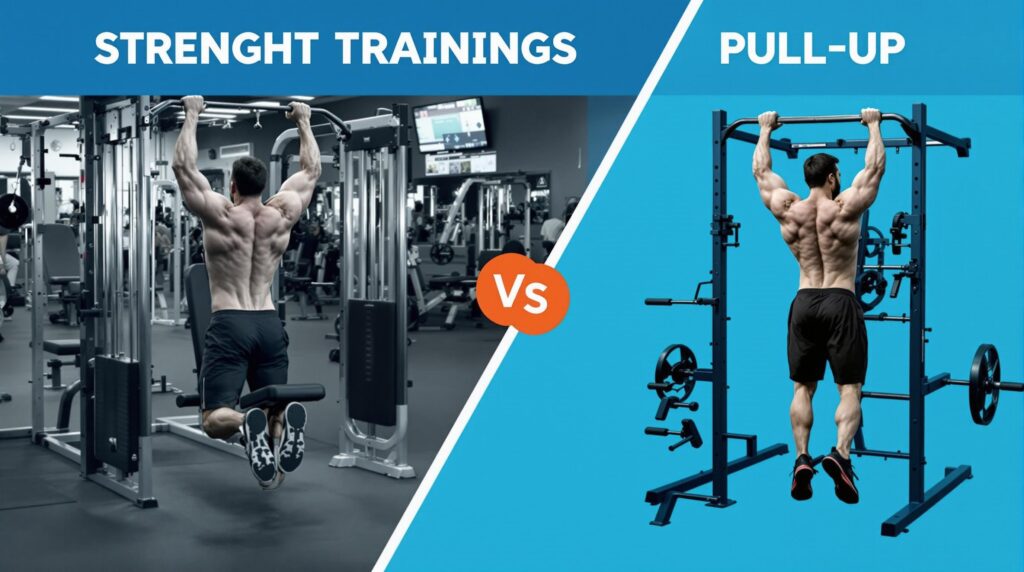The lat pulldown and pull-up both target similar muscle groups, but they differ significantly in execution, muscle activation patterns, and training adaptability. For those looking to develop a stronger, wider back, understanding the unique benefits and limitations of each exercise can help optimize your training program and progress toward your specific physique goals.
Key Takeaways
- Pull-ups generally activate more muscle fibers throughout the back and core compared to lat pulldowns
- Lat pulldowns allow for more precise weight adjustment and are more accessible for beginners
- Both exercises target the latissimus dorsi effectively but with different movement patterns
- For complete back development, incorporating both exercises into your routine is optimal
- Your specific goals and current fitness level should determine which exercise to prioritize
Anatomy of Back Training: Muscles Targeted
When comparing lat pulldown vs pull up exercises, it’s important to understand which muscles they target. Both movements primarily engage the latissimus dorsi (lats), the broad, flat muscles on the sides of your back that give you that coveted V-taper appearance. However, they also recruit the rhomboids, trapezius, rear deltoids, biceps, and forearm muscles.
The key difference lies in how these muscles are engaged. Pull-ups, being a bodyweight exercise, typically activate a greater number of stabilizing muscles throughout your core and upper body. The lat pulldown, performed on a machine, offers more isolation of the lat muscles with less demand on stabilizers.
Research conducted by the American Council on Exercise found that while both exercises effectively target the lats, pull-ups tend to create higher activation in the middle and lower trapezius muscles. This makes pull-ups slightly more comprehensive for overall back development, though the difference isn’t dramatic enough to exclude either exercise from your workout regimens for muscle growth.

Lat Pulldowns: Technique and Benefits
The lat pulldown is performed seated at a machine, pulling a bar down toward your chest or behind your neck. The controlled environment of this exercise makes it highly adaptable for all fitness levels. You can precisely adjust the weight, making it ideal for beginners or those building back strength.
One significant advantage of lat pulldowns is the ability to manipulate grip width and handle attachments easily. A wider grip emphasizes lat width, while a narrower grip can target the lower lats and involve more bicep activation. This versatility allows for targeted development of specific areas of the back.
Key benefits of lat pulldowns include:
- Greater control over weight progression in small increments
- Reduced risk of form breakdown compared to pull-ups
- Accessibility for beginners and those with limited upper body strength
- Ability to perform higher volume training with less fatigue
- Options to use various grip attachments (V-bar, rope, etc.) for different training stimuli
For those with shoulder mobility issues or injuries, lat pulldowns offer a safer alternative as they don’t require the full overhead position that pull-ups demand. This makes them particularly valuable in rehabilitation settings or for those with specific mobility limitations.
Pull-Ups: The Gold Standard for Back Development
Pull-ups represent one of the most challenging bodyweight exercises, requiring you to lift your entire body weight using primarily your back muscles. This compound movement engages not just your lats but a comprehensive chain of muscles including your core, shoulders, and arms.
The functional strength developed through pull-ups translates well to real-world activities and sports performance. Since pull-ups require more stabilization throughout the movement, they tend to build more neurological efficiency and coordination compared to machine-based exercises.
Major advantages of pull-ups include:
- Greater overall muscle recruitment throughout the posterior chain
- Development of functional, transferable strength
- Improved grip strength as a beneficial side effect
- No equipment needed beyond a sturdy bar
- More core engagement throughout the movement
For advanced trainees, pull-ups can be progressively overloaded by adding weight with a belt or weighted vest, though this progression is typically more challenging than simply adding weight to a lat pulldown machine. This makes pull-ups particularly effective for experienced lifters looking to continue challenging their back development in their gym workout plans to build muscle.
Biomechanics Comparison: Movement Patterns and Muscle Activation
When analyzing the biomechanics of lat pulldown vs pull up, several key differences emerge. In a pull-up, your body moves through space relative to a fixed bar, creating a closed kinetic chain exercise. This requires greater stabilization and typically results in higher neuromuscular demands.
In contrast, lat pulldowns represent an open kinetic chain where the weight moves relative to your fixed body position. EMG studies have shown that while both exercises effectively target the lats, pull-ups typically generate higher peak activation in most back muscles compared to pulldowns performed with equivalent resistance.
Another important biomechanical consideration is the direction of resistance. Pull-ups work directly against gravity in a vertical pull, while lat pulldowns employ a pulley system that can slightly alter the resistance curve. This difference subtly changes how the muscles are loaded throughout the movement, potentially affecting long-term development patterns.
For those concerned with building a wider back, the slight differences in muscle activation patterns between these exercises may be relevant. The stretch component at the bottom of a pull-up is typically more pronounced than in a lat pulldown, potentially leading to greater hypertrophic stimulus through the stretch-mediated growth pathway.
Practical Applications: Building Your Training Program
Rather than viewing these exercises as competitors, I recommend thinking of them as complementary movements that can be strategically incorporated into your training program. Your current fitness level, goals, and limitations should dictate how you balance these exercises.
For beginners or those unable to complete full pull-ups, starting with lat pulldowns allows for proper development of back strength and technique before progressing to pull-ups. You might incorporate assisted pull-ups (using bands or a machine) as a bridge between the two exercises.
Here’s a simple progression model:
- Beginners: Focus on lat pulldowns with proper form, gradually increasing weight
- Intermediate: Incorporate assisted pull-ups alongside lat pulldowns
- Advanced: Prioritize pull-ups (potentially weighted) with lat pulldowns as an accessory movement
For hypertrophy-focused training, higher volume approaches often work well, and the lat pulldown may allow you to accumulate more total volume due to the ease of adjusting resistance. For strength-focused goals, the pull-up’s higher intensity and greater stabilization requirements might make it the superior choice in your ultimate workout routine.
Programming Considerations: Sets, Reps, and Frequency
When programming these exercises, consider your training experience and recovery capacity. For most trainees, training the back 2-3 times weekly provides sufficient stimulus for growth while allowing adequate recovery.
For hypertrophy-focused training, consider this approach:
- Pull-ups: 3-5 sets of 5-12 reps (or maximum possible reps if fewer than 5)
- Lat pulldowns: 3-4 sets of 8-15 reps with moderate to heavy weight
For strength-focused training:
- Pull-ups: 4-6 sets of 3-6 reps, potentially with added weight
- Lat pulldowns: 3-4 sets of 6-10 reps with heavier weight
Alternating between vertical and horizontal pulling movements (like rows) within the same training session can optimize overall back development. This balanced approach ensures comprehensive development of all the muscles that contribute to a strong, aesthetically pleasing back.
Conclusion: Making the Right Choice for Your Goals
The debate of lat pulldown vs pull up doesn’t have a universal answer applicable to everyone. Both exercises offer significant benefits for back development with different advantages depending on your training experience, physical limitations, and specific goals.
For overall functional strength and maximum muscle recruitment, pull-ups generally have a slight edge. For targeted lat development with precise load control and accessibility, lat pulldowns offer distinct advantages.
The ideal approach for most people is to incorporate both exercises into their training regimen, either within the same session or across different training days. This provides varied stimulus to the back muscles, potentially leading to more complete development while preventing adaptation plateaus.
Remember that consistency with either exercise will yield results superior to constantly switching between them without progressive overload. Choose the variation that you can perform consistently with proper form, gradually increase the challenge, and your back development will follow.



